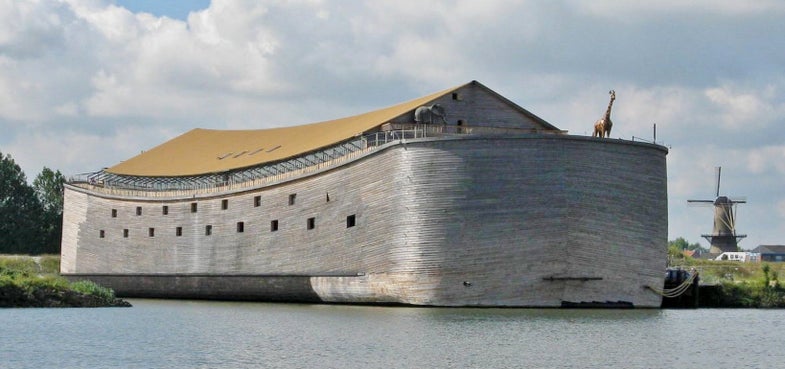Which Animal Species Would Fare Best After Noah’s Ark?
In which Popular Science worries about inbreeding.

This weekend Russell Crowe, as the lead role in Darren Aronofsky’s $125 million production of Noah, will pile countless animals into a wooden ark in anticipation of a watery apocalypse.
Here at_ Popular Science_, we know that when an animal population gets cut down dramatically, there’s a danger they’ll suffer from inbreeding. After all, early on in repopulating the world, they may only have relatives to choose from as mates—and mating with relatives increases the risk that offspring will get two copies of dangerously mutated genes, e.g. one from mom, one from dad, and zero alternative copies for a healthy mix.
Animal species differ wildly in their genetic diversity. Fruit flies, for example, have about ten times as much genetic variation as humans do. Individual nematode species are 100 times more varied. So we wondered if that meant nematodes, like this guy, would stay the healthiest after a catastrophic event like, oh, say, the biblical flood.
Brian Charlesworth, an evolutionary biologist at the University of Edinburgh in the U.K. and the editor-in-chief of the evolutionary biology journal Biology Letters, helped us explore which animals would be best protected from inbreeding after an extreme population drop. Charlesworth told us that the most important thing to look for in repopulation success is not genes—but how fast an animal species reproduces.
“I don’t think there’s really compelling evidence to say, ‘This organism has low genetic diversity and therefore it’s not going to do very well.’ If so, humans have a bleak future.”
Biologists know this from studying how animals fare after arriving on remote islands. Their success is determined by their ability to quickly multiply, Charlesworth says, “before they go extinct because of small population size or the failure of individuals to reproduce.”
In fact, biologists think that as long as a species reproduces quickly enough, it won’t lose too much of its natural diversity from a Noah’s Ark-like event. “If the population expands immediately, it doesn’t lose that much diversity from a bottleneck of two,” Charlesworth says. “It will maintain something like one quarter of variability that was there before.” He cited calculations published in the 1965 book The Genetics of Colonizing Species.
On the other hand, species whose population numbers would stay low for a long time are exposed to the risks of inbreeding. That’s good news for flies and mice; not so great news for elephants.
Making many babies matters more than inherent genetic variation because even animals with low genetic diversity generally have enough variability to weather a new environment. Charlesworth explained that humans aren’t so different from one another, at least genetically. Yet, within the last 10,000 years, different populations evolved the ability to resist malaria infections and to digest dairy products, depending on their needs.
“I don’t think there’s really compelling evidence to say, ‘This organism has low genetic diversity and therefore it’s not going to do very well,'” he says. “If so, humans have a bleak future.”
Biologists’ ability to put a number on species’ diversity comes from genetic sequencing technologies that have appeared only in the past decade or so. One cool corollary of that: By looking at how individuals within a species genetically vary from one another, biologists can find evidence of sudden reductions in population sizes in species’ past.
Thus, an event like the Biblical flood should leave its mark in most animals’ DNA—but Charlesworth says “there’s absolutely no evidence of any kind of bottleneck in the very recent past in the vast majority of species.”